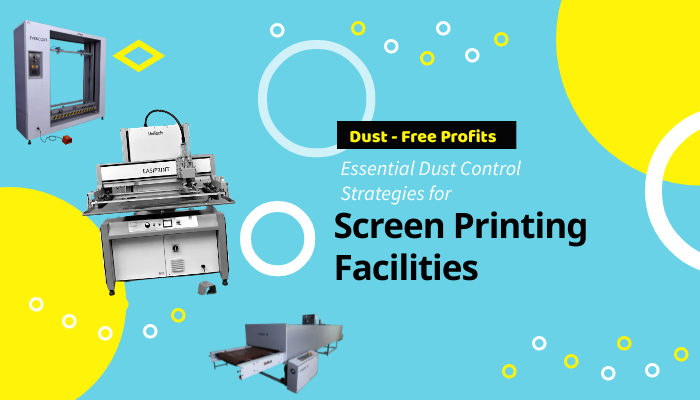“ Learn ceaselessly,
Get the best out of you ”
Get the best out of you ”
Dust-Free Profits - Essential Dust Control Strategies for Screen Printing Facilities

Dust poses a significant challenge in printing facilities, far surpassing the levels found in typical homes. It originates from various sources like materials, clothing, and environmental pollutants, contaminating screen-printing jobs and affecting both product quality and performance.
This contamination can lead to higher rejection rates, slower production speeds, and increased costs. Effective dust control is essential for improving efficiency and profitability. This article explores the origins of dust, its relationship with static electricity, and practical strategies for its removal and prevention, helping businesses reduce waste and enhance their bottom line.
Dust Generation in Printing Facilities
• Dust Sources - Slitting, sheeting, clothing, hair, corrugated boxes, environmental dust, other factories, reground plastics, and various industrial activities.
• Impact on Printing - Dust affects the appearance and performance of printed materials, especially in sensitive applications like electronic parts.
Importance of Dust Control
• Substrate Contamination - Dust contamination leads to higher rejection rates and lower production speeds.
• Scrap Rates - High dust levels result in significant material waste, increasing costs.
Example: A 10% scrap rate while printing 800 sheets/hr at Rs. 20/- sheet results in a Rs. 1600/hr loss.
Static and Dust Relationship
• Static Electricity - Generated through friction/separation, heat changes, and improper grounding, causing materials to attract dust.
• Lists materials based on their tendency to gain/loss electrons and generate static.
• Static Control Devices. Use ionizers to neutralize static charges, reducing dust attraction.
• Use of conveyorized dryer instead of drying trays is most effective and efficient.
Dust Control Techniques
• Sheet Cleaners
o Use polymer or adhesive rollers to remove dust. Can be offline or inline.
o Hand Rollers are Portable, suitable for small runs, using either polymer or adhesive film.
o Anti-static Wipes - Disposable, cotton cloths with an anti-static agent, used prior to printing.
• Printing shop - Environmental and Operational Practices
o General Housekeeping
o Keep doors/windows closed to prevent cross-ventilation of dust.
o Move fibrous materials away from the printing area.
o Wear non-fibrous clothing and use sticky floor mats.
• Shop Layout
o Position shipping/receiving away from printing areas.
o Avoid placing vents above presses.
o Regularly change air filters and clean ductwork.
o Ensure ceilings are in good condition to prevent dust fall.
• Cleaning Protocol
o Dust from the top down, use wet mops avoid recirculating dust.
• Humidity Control
o Maintain high humidity levels to reduce static.
• Collaboration with Suppliers
o Communication - Work with substrate suppliers to address and minimize contamination issues during material production and conversion.
• Clean Room Standards
o Adoption - Implementing clean room practices, even partially, can significantly reduce dust levels.
Example: Use of bunny suits, caps and sticky floor materials.
Conclusion
Effective dust control in screen-printing facilities is essential for maintaining high product quality and maximizing profitability. Dust contamination, static electricity, leads to defects and increased rejection rates. Implementing comprehensive dust control measures—such as static eliminators, sheet cleaners, and good housekeeping practices—can significantly reduce waste and improve operational efficiency. By prioritizing dust management, businesses can enhance product performance, lower costs, and boost overall profitability.